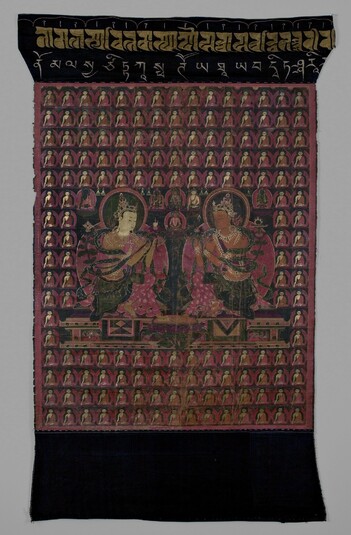
Item: Maitreya (Bodhisattva & Buddhist Deity)
| Origin Location | Tibet |
|---|---|
| Date Range | 1500 - 1599 |
| Lineages | Buddhist |
| Material | Ground Mineral Pigment on Cotton |
| Collection | John & Karina Stewart |
Classification: Deity
Maitreya and Manjushri, Bodhisattva (T. jang chub sem pa. E. Heroic Aspirant to Enlightenment). Maitreya, meaning loving kindness, and Manjushri (Manjughosha), melodious voice, are included among the eight special 'heart-sons' transcendent students of the Buddha Shakyamuni according to Northern Buddhism (Mahayana).
(The thumbnail image on the left is a 20th century painting of the same subject as above). Maitreya, on the left, is recognizable by the attributes of a golden wheel on his right and a water flask on the left - both placed atop flower blossoms. These two characteristic objects of the wheel and flask are unique to the artistic and iconographic appearance specific for Maitreya. Manjushri on the viewer's right holds the stems of two flower blossoms supporting a sword and book. The sword and book are the unique characteristic objects associated with Manjushri. In this painting both figures sit together on a single large throne with a broad lotus blossom rising up from below to serve as a foot rest. Between Maitreya and Manjushri are the small figures of the Five Symbolic Buddhas: Akshobhya, Vairochana, Ratnasambhava and Amitabha. Amoghasiddhi is placed slightly behind - to the right - of the head of Manjushri. A Medicine Buddha figure is placed behind - to the left - of the head of Maitreya.
Surrounding the central pair of bodhisattvas and Five Symbolic Buddhas are 163 buddha figures appearing in the typical posture of Shakyamuni Buddha with the right hand extended over the right knee. The number 163 seems somewhat random. It is possible that the Maitreya and Manjushri painting belongs to a set of seven paintings with each composition having approximately 163 buddha images - thus equaling the Thousand Buddhas of this Age.
The setting for the painting is the Tushita Heaven, Joyful Land, the abode of Maitreya, above Mount Sumeru, the center of a Buddhist world system, of which there are many, as he waits for the time when he will descend to earth and be the next Buddha after the time of Buddha Shakyamuni has passed.
The subject of this painting follows a Mahayana Buddhist narrative where Maitreya and Manjushri are having a discussion on philosophy. Probably the most famous depiction of this narrative is found in Dratang Monastery, Tibet, painted in the 11th century. Although damaged both by time and human events the beauty of the Dratang murals is immediately evident. There are some differences between the figures in the two paintings exhibited here and the figures in the mural. First, in the mural, the figures are reversed in seating position with Manjushri on the viewer's left. In the two paintings Maitreya is on the left. In the mural Manjushri has the single attribute of a book and Maitreya holds the single attribute of a water flask.
At the top of the brocade mount there is an embroidered inscription. The top row is the Nepalese decorative Ranjana script and below that is a row of Tibetan script with the words in the Sanskrit language: "na mo la sya tsi tta ka spha too ya tha ya ba dvi ta sha ri ra." The inscription continues beyond what is seen but has been cut off on the right side. The brocade and inscription do not immediately appear to be related to the subject of the painting but rather added as a decorative element.
The Artist: The style of painting is very unique with the unusual attention to facial features and slight changes in line that give character and personality. Also look to the single shared throne for all of the paired figures and the decorative cloth front piece with the square, checkered or triangle designs. This is most evident in another set of paintings depicting the Karma Kagyu lineage and very likely painted by the same artist as the Maitreya and Manjushri depicted above. Although the name of the artist is not currently known there is a very good possibility that it can be discovered by researching the names of artists of the mid 16th century through reading the biographical literature of the time. The Karmapa and Shamar Lamas of the day recorded many of their commissions, the artists names and the form of payment.
Jeff Watt 5-2011
Buddhist Deity: Maitreya Religious Context
Subject: Manjushri & Maitreya in Dialogue
Buddhist Deity: Maitreya (Seated Posture)
Collection: John & Karina Stewart (Painting)
Buddhist Deity: Maitreya (Painting Masterworks)
Collection: John & Karina Stewart (Painting Masterworks)

